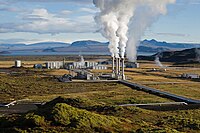
Photo from wikipedia
Through the research presented herein, it is quite clear that there are two thermodynamically distinct types (A and B) of energetic processes naturally occurring on Earth. Type A, such as… Click to show full abstract
Through the research presented herein, it is quite clear that there are two thermodynamically distinct types (A and B) of energetic processes naturally occurring on Earth. Type A, such as glycolysis and the tricarboxylic acid cycle, apparently follows the second law well; Type B, as exemplified by the thermotrophic function with transmembrane electrostatically localized protons presented here, does not necessarily have to be constrained by the second law, owing to its special asymmetric function. This study now, for the first time, numerically shows that transmembrane electrostatic proton localization (Type-B process) represents a negative entropy event with a local protonic entropy change (ΔSL) in a range from −95 to −110 J/K∙mol. This explains the relationship between both the local protonic entropy change (ΔSL) and the mitochondrial environmental temperature (T) and the local protonic Gibbs free energy (ΔGL=TΔSL) in isothermal environmental heat utilization. The energy efficiency for the utilization of total protonic Gibbs free energy (ΔGT including ΔGL=TΔSL) in driving the synthesis of ATP is estimated to be about 60%, indicating that a significant fraction of the environmental heat energy associated with the thermal motion kinetic energy (kBT) of transmembrane electrostatically localized protons is locked into the chemical form of energy in ATP molecules. Fundamentally, it is the combination of water as a protonic conductor, and thus the formation of protonic membrane capacitor, with asymmetric structures of mitochondrial membrane and cristae that makes this amazing thermotrophic feature possible. The discovery of energy Type-B processes has inspired an invention (WO 2019/136037 A1) for energy renewal through isothermal environmental heat energy utilization with an asymmetric electron-gated function to generate electricity, which has the potential to power electronic devices forever, including mobile phones and laptops. This invention, as an innovative Type-B mimic, may have many possible industrial applications and is likely to be transformative in energy science and technologies for sustainability on Earth.
Journal Title: Entropy
Year Published: 2021
Link to full text (if available)
Share on Social Media: Sign Up to like & get
recommendations!